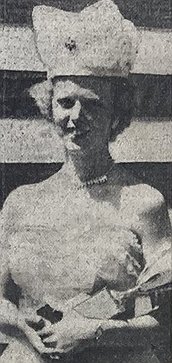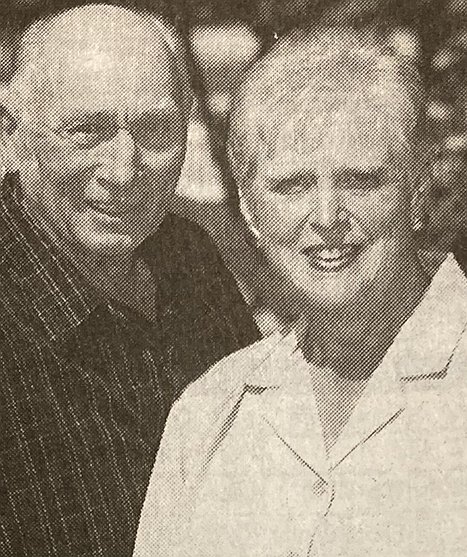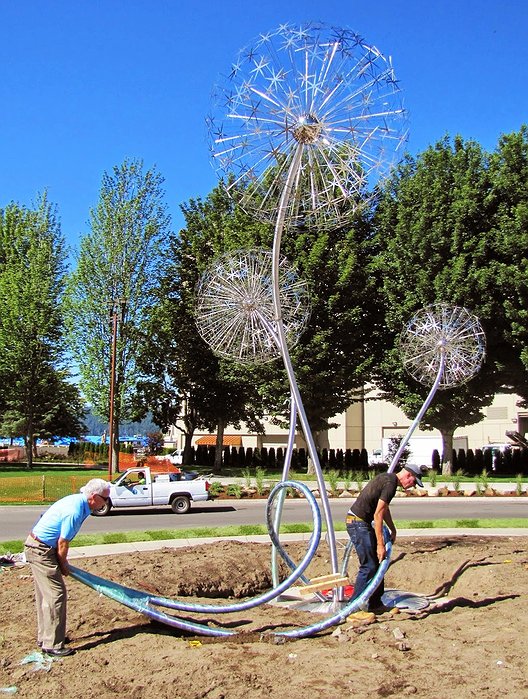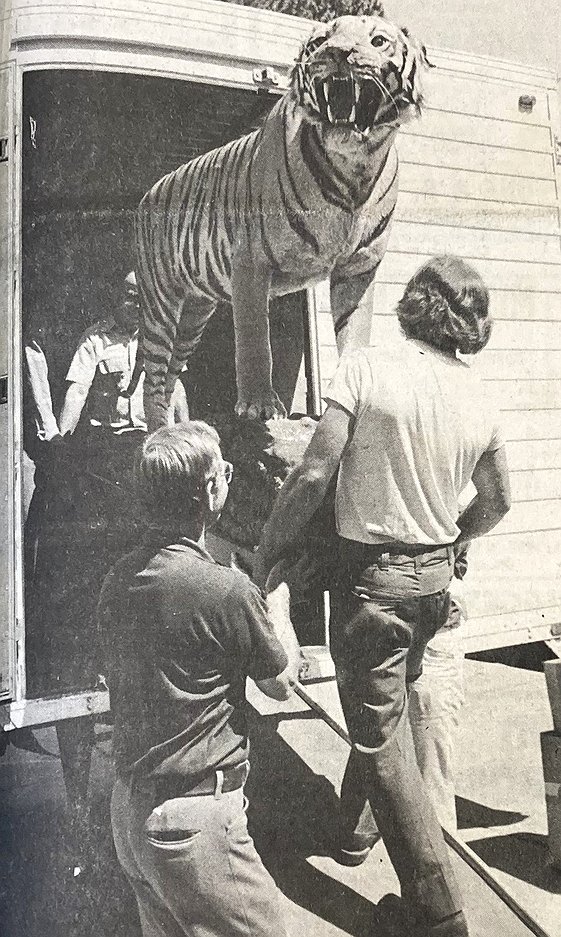HUCKLEBERRIES: Two grounds benefiting the people forever
Tubbs Hill and McEuen Park are miracles.
The hallowed ground that the two treasures share on the waterfront would be commercialized today if well-meaning — but myopic — civic leaders had had their way decades ago.
In the early 1960s, the City Council backed a plan to build a convention center on Tubbs Hill.
In the 1950s, town fathers crusaded to construct a shopping center on what is now McEuen Park.
Fortunately, grass-roots leaders, like former legislator Art Manley and environmental attorney Scott Reed, steered the community away from such madness.
Fifty-five years ago, Mayor Larry Gardner, Manley, Reed and others celebrated a major step in the preservation of Tubbs Hill. On July 25, 1969, they laid a 150-pound marble monument at the northwest corner of Tony Tubbs’ old hill with this inscription:
“1969. This land acquired for the benefit of the people forever.”
The ceremony capped a year of talks that prompted Idaho Water Company to sell 38 acres of Tubbs Hill to the city for $125,000.
“With this acquisition,” Mayor Gardner was quoted in the Press, “the city now owns about two-thirds of the hill, including all of the shoreline with the exception of a small area on the east.”
The city split the purchase price with the Bureau of Outdoor Recreation. The bulk of the local funding — $33,500 — came from an insurance settlement, received by the city, after an arson fire destroyed the USO-Civic Auditorium at City Park following World War II.
The 1969 purchase cost only $13 per front foot of lakeshore.
The city made two more major purchases and a minor one during the decade that followed.
Scott Reed’s book, “The Treasure Called Tubbs Hill,” sets the total cost paid by the city for 134 acres of Tubbs Hill and McEuen Park at $300,098. That doesn’t include federal matching funds or private donations. The purchases began in 1929 with a payment of $1.81 for a single lot and ended in 1980.
In 2006, Scott estimated the value of Tubbs Hill at $246 million.
Tubbs Hill is truly protected forever, Scott wrote, even if government officials “are asleep or bought off.” The federal funds that helped buy the hill had rigid conditions to guarantee recreational use.
Scott concluded: “Tubbs Hill is wrapped in a federal legal steel web.”
Oh beautiful
Our styling red, white, and blue vehicle license plate is a holdover from Idaho’s 1990 centennial celebration.
It’s similar but not the same.
For years, Idahoans advertised “Famous Potatoes” on simple green-and-white plates — thanks to the influential Idaho Potato Commission.
In 1987, Chairman Harry Magnuson and the Idaho Centennial Commission offered a better version for the centennial: A specialty plate that featured the colors of the U.S. flag and silhouetted trees and mountains. At the bottom, “Centennial” replaced “Famous Potatoes.”
The Automobile License Plate Collectors Association named the plate the best of 1987. And Idahoans loved it, too.
In Kootenai County, Cathie Gundle paid an extra $25 in July 1989 to buy the plate for son Brett’s pickup as a high school graduation gift.
It was a milestone purchase: The 90,000th centennial plate sold. The commission rewarded the Gundles with prizes, including a centennial T-shirt, license plate frames, dinner, and a trip to Boise to take part in the “Statehood Celebration Day” on July 3, 1990.
Said Cathie Gundle of the hoopla: “I think it is the most beautiful plate in the Pacific Northwest.”
Heartfelt
1954 was a momentous year for Barbara Smith, 18, of the tiny town of Springston.
She graduated from Harrison High, was crowned queen of the Harrison Old-Time Picnic, and married Harlan Renner.
A teacher told Barb that she was throwing her life away by rejecting scholarship offers for marriage. But she followed her heart.
A few months later, the Renners moved to Coeur d’Alene. And yada, yada, yada — Barb joined Tom Robb and Phil Grau to open what would become the iconic Iron Horse Bar & Grill in downtown Coeur d’Alene. And later still, as manager, she transformed the underused Kootenai County Fairgrounds, home of the North Idaho Fair, into a year-round going concern.
She and Harlan were married for 64-plus years until Harlan’s death parted them. Barb died last month.
She often credited her success to the love and support of Harlan and her daughters. The teacher from 70 years ago was wrong. Barb chose love, prospered, and made North Idaho a better place.
Fan mail
Emails Ron Hotchkiss about the 2004 ride that he gave 97-year-old Ace Walden’s in Ron’s 1907 Maxwell (Huckleberries, July 21): “Ace was a special man. I miss the long talks we used to have about local history and the way Cd'A once was. He was excited about going for a ride in the Maxwell and made prior arrangements with The Press to have his picture taken in the car. The photo was taken on the Dike Road, and Ace waved to people like he was in a parade.”
Huckleberries
• Poet’s Corner: When I was a lad, the nuns told us, “Boys,/the emptiest barrels make the most noises” — The Bard of Sherman Avenue (“On TV Pundits”).
• Oopsy: The name of Williene Gagnon, former owner of the old Wiggett Antique Mall, was spelled incorrectly. Emails Williene: “I have a unique name, many times mispronounced.”
• Factoid: The 14-foot “Allium Spring Chorus” sculpture, by artist David Tonnesen of Boston, Mass., consists of 2,800 separate pieces spread among three flower heads. In late July 2014, it became the third piece of public art placed at the overhauled McEuen Park. The design is based on the allium plant, a wild onion native to Idaho. The piece cost $110,000.
• Milestone: Among those handling the shovels to break ground for a new Coeur d’Alene High at Fourth and Dalton on July 22, 1969, were: Superintendent Clay Coy, CHS student president Tim Shepperd, and school board chairman Lloyd Diltz. The school was set to open in fall 1970.
• Killer in Town: A stuffed Indian tiger was on display among Ed Sverdsten’s animal collection when the Museum of North Idaho opened in an old Cenex store at 115 Northwest Boulevard. The tiger killed hundreds of people before being dispatched by Mrs. Sverdsten. MONI, which is on the move again, relocated to Northwest Boulevard on Aug. 10, 1979.
• Tested by Fire: Riverstone spreads over acreage that once featured two mills. And one of them, Idaho Forest Industries Atlas Mill (Stimson), lost 3.5 million of lumber — ready for shipping — in a suspected arson fire July 26, 1984. IFI officials estimated the loss at $4 million. The fire occurred on a Thursday night. And the mill planned to reopen Monday.
Parting shot
The late Sid Fredrickson enjoyed his job as city sewer czar. And he gave as well as he got in joking about that position. Ten years ago, he was in his element as the city celebrated 75 years in the sewer business, beginning Aug. 1, 1939. Free hot dogs and hamburgers were on the menu for a scheduled open house at the plant on the Spokane River. And that caused Sid to joke that visitors could choose when to eat lunch — before or after their tours. The city also planned fun, games, and crafts for the kids, prompting Sid to promise: “We won’t have bobbing for Baby Ruth candy bars.” As part of the program, Sid’s crew described “What Happens After the Flush.” City sewer lines, dating back to 1907, predated the original sewer plant. After the flush in those days, everything went into the river, which was OK — unless you lived downstream.
• • •
You can contact D.F. (Dave) Oliveria again at his previous newspaper email: dfo@cdapress.com.

















